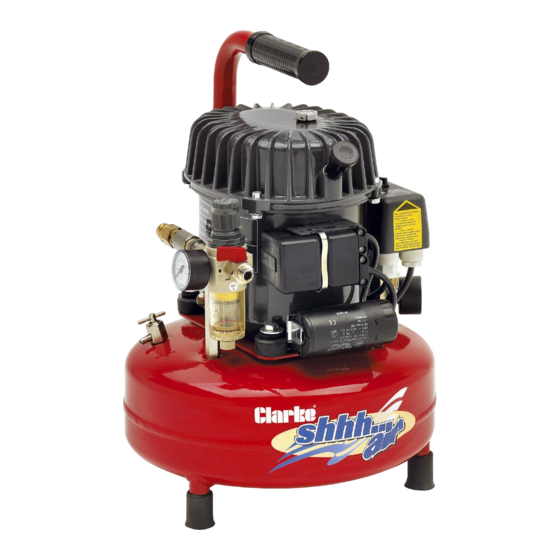Summary of Contents for Clarke SHHHAIR 50/9
- Page 1 SILENT AIR COMPRESSOR MODEL NO: SHHHAIR 50/9 PART NO: 2320870 OPERATION & MAINTENANCE INSTRUCTIONS ORIGINAL INSTRUCTIONS GC1220 - rev 10...
-
Page 2: Specification
INTRODUCTION Thank you for purchasing this Air Compressor. Before attempting to operate the machine, it is essential that you read this manual thoroughly and carefully follow all instructions given. In doing so you will ensure the safety of yourself and that of others around you, and you can also look forward to the product giving you long and satisfactory service. -
Page 3: General Safety Warnings
GENERAL SAFETY WARNINGS WARNING: WHEN USING ELECTRICAL TOOLS, BASIC SAFETY PRECAUTIONS SHOULD ALWAYS BE FOLLOWED TO REDUCE THE RISK OF FIRE, ELECTRIC SHOCK AND PERSONAL INJURY WARNING: READ ALL THESE INSTRUCTIONS BEFORE ATTEMPTING TO OPERATE THIS PRODUCT AND KEEP THESE INSTRUCTIONS IN A SAFE PLACE. WORK AREA 1. - Page 4 GENERAL MACHINE USE AND CARE 1. Prior to use, all operators should become familiar with the instructions in this booklet especially the ON/OFF switch for emergency stopping. 2. ALWAYS maintain the compressor with care and keep it clean for best / safest performance.
- Page 5 AIR COMPRESSOR SAFETY INSTRUCTIONS 1. ONLY USE WITHIN THE RECOMMENDED OPERATING TEMPERATURE RANGE: This compressor should only be used in an ambient temperature of between +5 C and +40 C (never at or below freezing temperatures). 2. NEVER USE AN AIR COMPRESSOR WHICH APPEARS DEFECTIVE OR IS OPERATING ABNORMALLY: If the compressor operates unusually or makes strange noises, switch off immediately and purge the air reservoir.
-
Page 6: Electrical Connections
ELECTRICAL CONNECTIONS WARNING! READ THESE ELECTRICAL SAFETY INSTRUCTIONS THOROUGHLY BEFORE CONNECTING THE PRODUCT TO THE MAINS SUPPLY. Before switching the product on, make sure that the voltage of your electricity supply is the same as that indicated on the rating plate. This product is designed to operate on 230VAC 50Hz. -
Page 7: Preparing For Use
1. Make sure that the oil level is half way up the oil sight glass. 2. If not, remove the oil cap and top up the reservoir. • Only use Clarke synthetic compressor oil, available from your Clarke dealer (Part No. 3050795). -
Page 8: Switching The Air Compressor On
FITTING THE REGULATOR 1. Fit the regulator into position as shown. • Do not overtighten the nut. SWITCHING THE AIR COMPRESSOR ON 1. To start the compressor, turn the ON/OFF switch to the ‘I’ (ON) position - the motor should start immediately. -
Page 9: Shutting Down The Compressor
NOTE: If the machine pumps continuously without cutting out then the compressor is too small for the application/tool being used, and damage may result. Consult your Clarke dealer. NOTE: DO NOT exceed the duty cycle for the machine (see Specifications). -
Page 10: Draining The Reservoir
3. Before transporting your compressor or when leaving overnight, expel all air from the receiver by opening the vent valve. DRAINING THE RESERVOIR 1. Pressurise the reservoir slightly and then turn the compressor off. 2. Attach the small hose supplied to the vent valve as shown. -
Page 11: Troubleshooting
TROUBLESHOOTING PROBLEM PROBABLE CAUSE REMEDY The compressor will not Bad connections Check the electrical start, or stops and will not connections start again Blown fuse Replace fuse Overload cutout switch Wait 25-20 mins before has tripped attempting to restart Compressor does not start Air receiver charged Open drain valve to expel air. -
Page 12: Maintenance
MAINTENANCE Daily Monthly Yearly Check the oil level Drain the water collected in the air outlet filter. See Draining the Reservoir on page 10. Remove the condensate that has collected in the air tank. See Draining the Reservoir on page 10. Once a month check the compressor for loose connections, wear, etc. -
Page 13: Check The Non Return Valve
CHECK THE NON RETURN VALVE If the tank pressure decreases for no apparent reason, it is possible that the non-return valve is leaking. To check, ensure the tank is under pressure and the machine switched OFF, 1. Take off the flexible hose and check if air leaks out from the valve. -
Page 14: Environmental Recycling Policy
ENVIRONMENTAL RECYCLING POLICY By purchasing this product, the customer is taking on the obligation to comply with current WEEE regulations. This means that this product must not be disposed of with general household waste. It must be disposed of according to the laws governing Waste Electrical and Electronic Equipment (WEEE) at a recognised disposal facility. -
Page 15: Parts Diagram
PARTS DIAGRAM... - Page 16 PARTS DIAGRAM...
-
Page 17: Component Parts List
COMPONENT PARTS LIST DESCRIPTION C0037 Screw TCEI 6X20 C0051 Rylsan Hose ?4/6 C0106 Spacer T21 C0077 Swivel Connector M1/4 C0109 Capacitor Bracket C0082 Pressure 1 WAY C0111 Overload Protector T2134A C0083 Connection M 1/4 L=80 (230V) C0112 Start Relay T21 (230V) C0089 Nipple 1/4"... - Page 18 WIRING DIAGRAM & FLOW CHART...
-
Page 19: Declaration Of Conformity
DECLARATION OF CONFORMITY...
















Need help?
Do you have a question about the SHHHAIR 50/9 and is the answer not in the manual?
Questions and answers